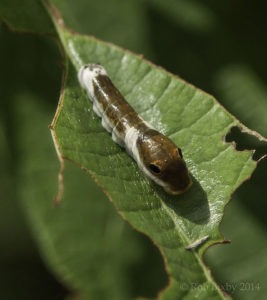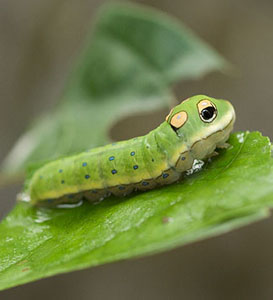
The ghouls and goblins of Halloween got me thinking about mimicry in the natural world. Mimicry is when an animal has evolved to look like something else. The spicebush swallowtail caterpillar provides some of my favorite examples of mimicry among Kentucky’s butterflies.
The spicebush swallowtail (Papilio troilus) can be found throughout the eastern U.S. It is a pretty black and blue butterfly with orange spots on the undersides of its wings. The butterflies feed on the nectar of a variety of flowers. They can most often be found in open woodlands or nearby open areas. Spicebush butterflies will go through two to three life cycles each summer in Kentucky. The females lay their eggs primarily on either spicebush (Lindera benzoin) or sassafras (Sassafras albidum) leaves.
Although I think the spicebush butterflies are pretty, it’s their caterpillars that exhibit the mimicry that I think is so interesting. When the spicebush caterpillar first hatches, it is small, dark brown or black, and has a white spot or streak. Its coloration mimics the look of bird droppings. Since most birds don’t go around eating their poop, the caterpillars are able to fool many of their avian predators.
Like other insects, caterpillars must molt their exoskeleton in order to grow. Spicebush swallowtail caterpillars will go through five molts (called instars) before forming a chrysalis and turning into a butterfly. The caterpillars in the first three instars look like bird poop. By the fourth instar, the caterpillar is too big to pull off a convincing bird poop mimicry.
The fourth and fifth instars are either green or orange with giant eye spots. In these two stages, the caterpillar mimics a snake’s head. If startled, the caterpillar will even curl its own head under while raising up the “snake head” to further the illusion of it being a snake.

In addition to mimicking either bird poop or a snake head, the caterpillars have another important method for avoiding predators. Spicebush swallowtail caterpillars are most active at night. They spend most of the day wrapped up in a leaf resting or molting and hiding from predators. If a bird happens to unroll the leaf that the caterpillar is hiding in, then it is confronted with what looks like an unappealing pile of droppings or the head of a snake peering back at it.
When it comes time for the caterpillar to form a chrysalis and pupate, it performs one last mimicry. The chrysalis looks like a curled up leaf. Caterpillars that pupate early in the season will form a green chrysalis because the leaves at that time of the year are mostly green. However, if it is late in the season and the caterpillar will be spending the winter as a pupae, then the chrysalis is brown thus resembling a dead leaf.
For us, Halloween’s mimicry is just a fun festivity. In the natural world, mimicry can mean the difference between life and death. The spicebush swallowtail is a master at mimicry. Its mimicry of bird droppings, a snake head, and a curled up leaf give it the best chance of surviving to adulthood, mating, and starting the cycle over again with the next generation of spicebush swallowtails.



This article was part of Shannon’s original Kentucky Pollinators and Backyard Wildlife blog which evolved into the blog for Backyard Ecology.

Backyard Ecology: Exploring Nature in Your Backyard
Nature isn’t just “out there.” It’s all around us, including right outside our doors. Hi, my name is Shannon Trimboli, and I am the host of Backyard Ecology. I live in southcentral Kentucky and am a wildlife biologist, educator, author, beekeeper, and owner of a nursery specializing in plants for pollinators and wildlife conservation. I invite you to join me as we ignite our curiosity and natural wonder, explore our yards and communities, and improve our local pollinator and wildlife habitat. Learn more or subscribe to my email list at www.backyardecology.net.

Leave a Reply